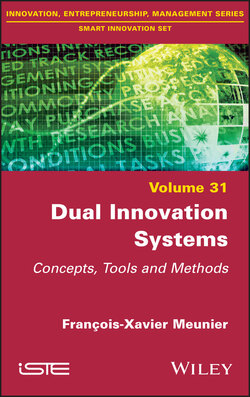Читать книгу Dual Innovation Systems - Francois-Xavier Meunier - Страница 8
Оглавление
Introduction to Part 1
Technological production is partly driven by the intended uses of the developed technology. This does not exclude the possibility that certain technologies simultaneously have multiple uses. Putting together defense innovation and civilian innovation for the joint production of technologies that are useful to both civilian and defense domains is a challenge that can be addressed by gaining a certain understanding of technology production and dissemination mechanisms.
This first part of the book aims to build the theoretical framework for studying various modes of interaction between the defense innovation sector and the civilian innovation sector. Starting in the 1980s, technological duality has been dealt with in many works (Gummett and Reppy 1988; Alic 1994; Cowan and Foray 1995; Molas-Gallart 1997; Kulve and Smit 2003; Mérindol and Versailles 2015b), but the manner in which it is defined often varies from one author to another. It is nevertheless easy to get a sense of dual innovation, whose common and prosaic definition is the search for synergies between defense and civilian sectors in the innovation process. However, distinguishing it from related and sometimes amalgamated notions, such as dual-use items, technology transfers, spin-offs and spillovers, is not always an easy task. Whatever the case, the most recent works seem to agree on the systemic nature of dual innovation (Guichard 2004a; Mérindol and Versailles 2010; Acosta et al. 2013) and in order to integrate all the dimensions of duality, this is the path followed in building the theoretical framework proposed here.
The analysis will however focus on the purely technological dimension and the perspective adopted for this purpose is that of the technological system, as defined by Carlsson and Stankiewicz (1991) as a flow of knowledge and competences. Due to this approach to technology, the specific role of knowledge flows can be pointed out. As will be shown further on, these differ from other flows of goods or services and have an essential role in the definition of dual potential. In this context, the way knowledge dissemination is dealt with is crucial. In line with the above, a systemic perspective will be adopted here.
This first part of the book aims to propose a “universal” framework of analysis of duality, which facilitates an analysis focused on one of its components and its integration in the broader perspective of innovation systems. In terms of knowledge dissemination, this proposal opens up the way to creating a set of tools that will enable, in addition to the case studies, the measurement of the dual potential of various technological systems. The first step is to understand how knowledge production is a vector of technological proximity between the civilian sector and the defense sector and how this proximity can be measured.
This part is composed of three chapters that successively present the concept of duality, the method used for the study of knowledge dissemination and the definition of an original framework of analysis for the subsequent study of duality.
